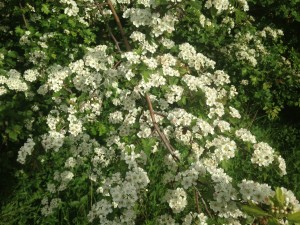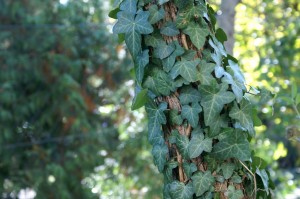 At the weekend I became a volunteer for Plantlife and took part in their Wildflowers Count survey
At the weekend I became a volunteer for Plantlife and took part in their Wildflowers Count survey
I had to walk across an allocated 1km square and record which plants out of a list of 200 I saw. Luckily, the list has such challenging species as Holly, Hawthorn, Common Nettle, Ivy and Daisy so I knew I would be able to identify some of them.
The good thing about walking across the square is that you then have to walk back – so you get a second go. The particularly good thing about this square, and, remember, they gave it to me (I didn’t ask for it), is that there is a pub at the far end of the walk where one can sit in the garden and look at plant books to figure out any identification puzzles. I’ve only visited this square once and I really like it already!
I should tell you what the square is like, I guess. Well, it’s in the valley of the River Nene, so much so that I crossed the river about half way along my stroll, and is a bit of arable farmland and a bit of scrubby, nothingy, messy stuff around the river. I must clean up the habitat definitions before I send in my data to Plantlife.
I’d already worked out a route on rights of way before we set off but attempting to walk them revealed a feature of the British countryside – some of them weren’t really there. But some other paths, well-used paths, were there. It was fine really.
There were some birds, but I wasn’t allowed to pay much attention to them as I was concentrating hard on spotting a plant or two. Although, I have to mention that there was a Cuckoo singing for much of the walk – there really are more of them around this year, I’m sure.
The documentation for the survey is pretty good – although I would have a few suggestions as to how it could be improved.
And I felt heroic looking at plants in May when there are plenty of birds to look at.

I also felt like a complete novice – which was a strange mixture of slightly unnerving and rather exhilarating. But I am familiar with talking to people about birds and them saying ‘Oh, I don’t know anything about birds or how to identify them’. I quite enjoy this as it is usually untrue, and I play a little game by saying ‘I bet you know [name a bird] don’t you?’ and the person will say ‘Oh yes! I know that’. And then one can say ‘And you know [name another bird], don’t you?’. And they usually say ‘Oh yes!’, and I can often get into the 20s before they admit to not knowing what a particular bird is like. I suppose my plant knowledge, poor though it is, is not completely absent – I do know a few, in fact quite a few, plants (although I do hide this knowledge very well).
We recorded 20 of the 200 target species on our walk. I don’t know how many we missed. With birds, I would be fairly sure (although – who really knows?), on a similar walk, that I would have heard or seen and correctly identified most of the species in view or in hearing. Although plants can’t fly away they don’t exactly jump out at you either, do they? They just sit there looking rather green – almost all of them.
We must return, during opening hours of the pub I suspect, some time in 6-8 weeks so I suspect that will be in mid-July, to see what other species we might find on our route that are then in flower or at least more obvious than they were on Saturday. And, do you know, I am quite looking forward to it.
If you get a move on, you too, could go for a walk, record some plants (because your plant knowledge must be greater than mine – honestly, it must) and be part of this survey. I’d advise taking a companion with you, ideally someone with fantastic plant knowledge and ideally someone who likes beer too.
[registration_form]
It sounds like you have been given a really good patch to study. I have convinced mum and dad to let our grass grow wild this year and see what comes up. They did a deal and have strimmed a path down each side, but there is all sorts of stuff coming up. I just need to try and identify it all now, but there are already lots more bugs in the garden enjoying the new habitat.
Findlay – good for you. I’m doing that too. In my garden it is a strip down one side next to a fence. I have noticed the extra insects too. And i don’t have to cut that bit of grass. I’m not sure that any really interesting plants are going to appear but we’ll see. We must compare notes as time goes on.
You might be surprised at the number of species of grass that comprise your “grass”. It’s easier to identify them when they flower, obviously, but if you can get hold of a copy of Hubbard’s “Grasses” there is a key for identification from vegetative characters in there. I wore my copy out by the time I was old enough to vote. Now I am 94 I have forgotten most of what I gleaned from it, and those irritating taxonomists have changed a lot of names for no good reason, but I still love the smell of sweet vernal grass in the morning.
Totally agree with Filbert, you really can’t beat a bit of Sweet Vernal Grass in the morning, especially after a thunderstorm like what we had last night….just don’t chew it too long!
The correct time is Comfortably Numb
A lovely blog today, Mark. How good to read the comments from Findlay and Filbert and to see that you reach out to all ages. I thought I was knocking on a bit but I hope I can write as well as them both in another 20 years or so!
We also have let the “grass” run riot this year with just a couple of paths cut through, mostly buttercups and daisies at present but a good show of primroses and cowslips earlier. Hope the insects are enjoying any extra nectar.
Be careful Mark, plant hunting can become addictive, if you know what I mean. The keen plant hunter has to be a mountaineer, a bog walker and everything in between. Good luck.
Diapensia – I can imagine that…
With apologies to Sir Harry Godwin: “any fool can appreciate birds but it takes a person of discernment to appreciate wild plants”